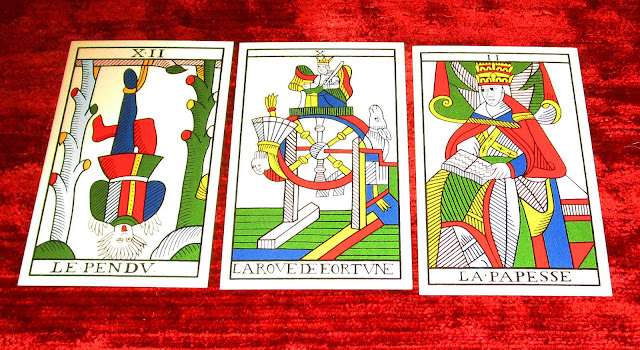“But what I like to say in
lieu of an answer, is that card readers are good at participating in the
creation of ‘fictional truth’.” Camelia
Elias
“We can see how, as a
pataphysical machine, the Marseilles tarot can help us reach those two degrees
of separation with reality that pataphysics prescribes, but a warning is in
order: we may end up eating the bread crumbs trail we left behind to orient
ourselves, never finding our way back home.” Enrique Enriquez
In two recent offerings
(One, Two), I explore Enrique Enriquez’ characterization of the Tarot of Marseilles as a
“’Pataphysical Machine”, a refinement of Jodorowsky’s “Metaphysical Machine”
depiction.
Instead of further engaging
the Marseilles as a participant without conceptual input into the design of these rather odd pata-experimental operations
and maneuvers, I thought that it may be a good idea to get some opinions from
the deck herself prior to continuing with Part III, hence the following
exchange…
Marseilles, what can you
expose about the relationship between ‘Pataphysics and the Tarot that we may
not be aware of?
 |
| Answer 1 |
So, what are Temperence and
The Charioteer looking at?
 |
| Answer 2 |
And what is the Popesse
looking at?
 |
| Answer 3 |
Oh, I see. So what do you
make of Alfred Jarry’s statement “the virtual or imaginary nature of things as
glimpsed by the heightened vision of poetry or science or love can be seized
and lived as real”?
 |
| Answer 4 |
So, what is the Popesse
looking at now?
 |
| Answer 5 |
And what is in Death’s
gaze?
 |
| Answer 6 |
Yes, always the ecstatic alchemist, Jarry indeed danced too close to the edge...perhaps. What's your hypothesis regarding a (fictive) solution to our conundrum?
 |
| Answer 7 |
Ah...a riddle within the riddle, do you have anything
else to tell us?
 |
| Answer 8 |
And the Pope’s gaze?
 |
| Answer 9 |
Thank you Marseilles...we shall carry on with our investigations. Hopefully, we will do Jarry justice.














